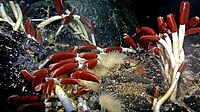
Environmental stress promotes the persistence of facultative bacterial symbionts in amoebae
Sign Up to like & getrecommendations! Published in 2023 at "Ecology and Evolution"
DOI: 10.1002/ece3.9899
Abstract: Abstract Amoebae are one major group of protists that are widely found in natural and engineered environments. They are a significant threat to human health not only because many of them are pathogenic but also… read more here.
Keywords: stress; facultative bacterial; bacterial symbionts; environmental stress ... See more keywords

Uncovering Active Bacterial Symbionts in Three Species of Pollen-feeding Beetles (Nitidulidae: Meligethinae).
Sign Up to like & getrecommendations! Published in 2022 at "Microbial ecology"
DOI: 10.1007/s00248-022-01964-3
Abstract: Microbial symbionts enable many phytophagous insects to specialize on plant-based diets through a range of metabolic services. Pollen comprises one-plant tissue consumed by such herbivores. While rich in lipids and proteins, its nutrient content is… read more here.
Keywords: bacterial symbionts; uncovering active; symbionts three; active bacterial ... See more keywords

Defensive symbiosis against giant viruses in amoebae
Sign Up to like & getrecommendations! Published in 2022 at "Proceedings of the National Academy of Sciences of the United States of America"
DOI: 10.1073/pnas.2205856119
Abstract: Protists are important regulators of microbial communities and key components in food webs with impact on nutrient cycling and ecosystem functioning. In turn, their activity is shaped by diverse intracellular parasites, including bacterial symbionts and… read more here.
Keywords: symbiosis giant; defensive symbiosis; symbiont; bacterial symbionts ... See more keywords

The fly factor phenomenon is mediated by interkingdom signaling between bacterial symbionts and their blow fly hosts
Sign Up to like & getrecommendations! Published in 2018 at "Insect Science"
DOI: 10.1111/1744-7917.12632
Abstract: We tested the recent hypothesis that the “fly factor” phenomenon (food currently or previously fed on by flies attracts more flies than the same type of food kept inaccessible to flies) is mediated by bacterial… read more here.
Keywords: traps baited; factor phenomenon; bacterial symbionts; fly factor ... See more keywords

The Cost of Metabolic Interactions in Symbioses between Insects and Bacteria with Reduced Genomes
Sign Up to like & getrecommendations! Published in 2018 at "mBio"
DOI: 10.1128/mbio.01433-18
Abstract: Current understanding of many animal-microbial symbioses involving unculturable bacterial symbionts with much-reduced genomes derives almost entirely from nonquantitative inferences from genome data. To overcome this limitation, we reconstructed multipartner metabolic models that quantify both the… read more here.
Keywords: insects; bacterial symbionts; metabolic models; host ... See more keywords

Comparative Genomics of Facultative Bacterial Symbionts Isolated from European Orius Species Reveals an Ancestral Symbiotic Association
Sign Up to like & getrecommendations! Published in 2017 at "Frontiers in Microbiology"
DOI: 10.3389/fmicb.2017.01969
Abstract: Pest control in agriculture employs diverse strategies, among which the use of predatory insects has steadily increased. The use of several species within the genus Orius in pest control is widely spread, particularly in Mediterranean… read more here.
Keywords: ancestral symbiotic; bacterial symbionts; symbiotic association; orius species ... See more keywords

Pyrosequencing Uncovers a Shift in Bacterial Communities Across Life Stages of Octodonta nipae (Coleoptera: Chrysomelidae)
Sign Up to like & getrecommendations! Published in 2019 at "Frontiers in Microbiology"
DOI: 10.3389/fmicb.2019.00466
Abstract: Bacterial symbionts of insects affect a wide array of host traits including fitness and immunity. Octodonta nipae (Maulik), commonly known as hispid leaf beetle is a destructive palm pest around the world. Understanding the dynamics… read more here.
Keywords: bacterial symbionts; life stages; octodonta nipae; larvae pupae ... See more keywords

Roles of Bacterial Symbionts in Transmission of Plant Virus by Hemipteran Vectors
Sign Up to like & getrecommendations! Published in 2022 at "Frontiers in Microbiology"
DOI: 10.3389/fmicb.2022.805352
Abstract: The majority of plant viruses are transmitted by hemipteran insects. Bacterial symbionts in hemipteran hosts have a significant impact on the host life, physiology and ecology. Recently, the involvement of bacterial symbionts in hemipteran vector-virus… read more here.
Keywords: bacterial symbionts; plant virus; transmission; roles bacterial ... See more keywords

Locust Bacterial Symbionts: An Update
Sign Up to like & getrecommendations! Published in 2020 at "Insects"
DOI: 10.3390/insects11100655
Abstract: Simple Summary Locust plagues have been devastating vegetation and agriculture since ancient times. The tendency of locusts to form huge swarms and migrate long distances is a hallmark of the locust phenomenon. The ecological and… read more here.
Keywords: insects; bacterial symbionts; research; locust bacterial ... See more keywords

Bacterial Symbionts in Ceratitis capitata
Sign Up to like & getrecommendations! Published in 2022 at "Insects"
DOI: 10.3390/insects13050474
Abstract: Simple Summary The Mediterranean fly (Medfly), Ceratitis capitata, is considered one of the world’s most destructive fruit pests, as it can attack commercially important fruit, thus causing considerable economic damages, estimated to be more than… read more here.
Keywords: ceratitis capitata; insects; control; bacterial symbionts ... See more keywords